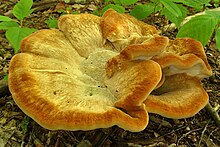| Bondarzewia berkeleyi | |
|---|---|

| |
| Scientific classification | |
| Kingdom: | |
| Division: | |
| Class: | |
| Order: | |
| Family: | |
| Genus: | |
| Species: | B. berkeleyi
|
| Binomial name | |
| Bondarzewia berkeleyi | |
| Synonyms | |
| |
Bondarzewia berkeleyi, commonly known as Berkeley's polypore,[1] or stump blossoms,[2] is a species of polypore fungus in the family Russulaceae. It is a parasitic species that causes butt rot in oaks and other hardwood trees.[3] A widespread fungus, it is found in Africa, Asia, Europe, and North America.[4]
Elias Magnus Fries described the species as Polyporus berkeleyi in 1851. It was moved to the genus Bondarzewia in 1941.[5]
The fan- or shelf-shaped caps grow in overlapping clumps from the bases of oak trees, each capable of growing to 25.5 cm (10 in) diameter. They are various shades of white to pale grey, cream, beige or yellow. The pore surface is white, as is the spore print. The round spores are 7–9 by 6–8 μm and have marked amyloid ridges. The tough white flesh can be up to 3 cm (1.2 in) thick and has a mild taste, which can be bitter in older specimens. The outer edges that cut easily with a knife are quite tender. Although Bondarzewia berkeleyi has been compared to eating shoe leather,[3] some field guides list it as edible.[6] It may be able to be used to strengthen other flavors in dishes, much like tofu. It can also reportedly be used as a meat substitute.[7] Other field guides list it as inedible.[8]
In China it has been recorded from Guangdong and Hunan provinces.[4][9] The fruit bodies appear over July to October in the United States.[1] A survey of host trees in North Carolina found that it almost always grew on oaks, being recorded from the white oak (Quercus alba), scarlet oak (Q. coccinea), southern red oak (Q. falcata), chestnut oak (Q. prinus) and eastern black oak (Q. velutina), as well as bird cherry (Prunus pensylvanica).[10]
See also[edit]
References[edit]
- ^ a b Bessette A. (2007). Mushrooms of the Southeastern United States. Syracuse University Press. p. 250. ISBN 978-0-8156-3112-5.
- ^ Roody WC (2003). Mushrooms of West Virginia and the Central Appalachians. Lexington, Kentucky: University Press of Kentucky. p. 348. ISBN 0-8131-9039-8.
- ^ a b Kuo M, Methven A (2010). 100 Cool Mushrooms. Ann Arbor, Michigan: University of Michigan Press. p. 33. ISBN 978-0-472-03417-8.
- ^ a b Zhishu B, Zheng G, Taihui L (1993). The Macrofungus Flora of China's Guangdong Province. New York, New York: Columbia University Press. p. 153.
- ^ Bondartsev A, Singer R (1941). "Zur Systematik der Polyporaceae". Annales Mycologici. 39 (1): 43–65.
- ^ Phillips, Roger (2010). Mushrooms and Other Fungi of North America. Buffalo, NY: Firefly Books. p. 297. ISBN 978-1-55407-651-2.
- ^ Brill S. (2010). The Wild Vegan Cookbook: A Forager's Culinary Guide (in the Field Or in the Supermarket) to Preparing and Savoring Wild (and Not So Wild) Natural Foods. Houghton Mifflin Harcourt. p. 199. ISBN 9781558327214.
- ^ Miller Jr., Orson K.; Miller, Hope H. (2006). North American Mushrooms: A Field Guide to Edible and Inedible Fungi. Guilford, CN: FalconGuides. p. 420. ISBN 978-0-7627-3109-1.
- ^ Dai YC, Härkönen M, Niemelä T (2003). "Wood-inhabiting fungi in southern China 1. Polypores from Hunan Province" (PDF). Annales Botanici Fennici: 81–93.
- ^ Grand LF, Vernia CS (2007). "Biogeography and hosts of period wood decay fungi in North Carolina: Species of Abortiporus, Bondarzewia, Grifola, Heterobasidion, Laetiporus, and Meripilus" (PDF). Mycotaxon. 99: 99–102.
External links[edit]
- Bondarzewia berkeleyi in Index Fungorum
 Media related to Bondarzewia berkeleyi at Wikimedia Commons
Media related to Bondarzewia berkeleyi at Wikimedia Commons